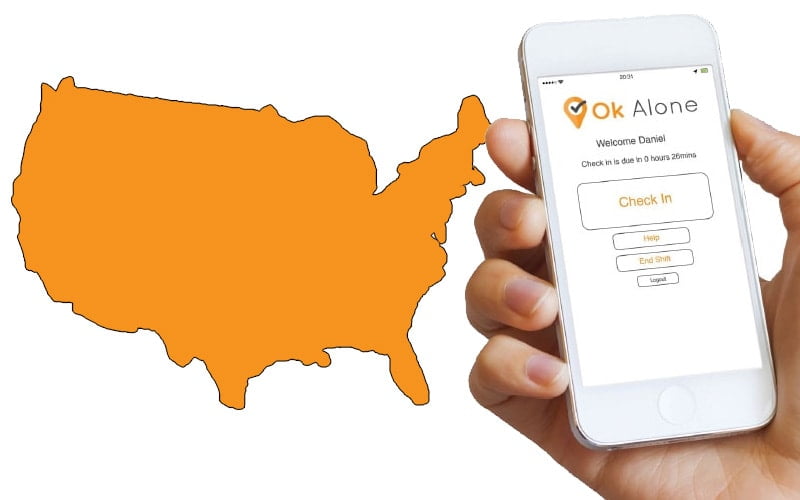OSHA + Legislation & Policy for Lone Workers in the USA

Here is a summary of the lone worker legislation and policy in the United States of America including regulations and information about the Occupational Safety and Health Administration.
Who are OSHA and what do they do?
The Occupational Safety and Health Administration (OSHA) is run by the United States Department of Labor and was created to assure safe and healthy working conditions for working men and women by setting and enforcing workplace standards and by providing training, outreach, education and assistance.
OSHA provide guidance on protecting all employees through the use of the standards. The Occupational Safety and Health Act 1970 is the primary federal legislation governing worker safety in the USA, for traditional office-based employees to self-employed, contractors and lone workers.
Who does OSHA regulate?
As a government body, OSHA regulates most private sector employers and
their workers, in addition to some public sector employers and workers in the
50 states and certain territories and jurisdictions under federal authority.
Lone Working Legislation USA
Health and safety legislation differ slightly across the US states, however, USA health and safety legislation are yet to officially incorporate lone working. OSHA cites having a work alone policy as a general duty. OSHA does not have a specific requirement to develop and implement a work alone policy. But failure to have a policy could be considered a General Duty OSHA requirement and has been cited by OSHA in the past under the General Duty statute. They have a Severe Violator Enforcement Program which enforces regulations – and imposes civil penalties, including fines, for non-compliance.
Occupational Safety and Health Act and Lone Working
The only legislation within the Occupational Safety and Health Act 1970 that refers to lone working is specifically for those working on a Shipyard (Occup. Safety and Health Standards for Shipyard Employment), however, item 1915.84 gives sound advice and should be applied to all lone workers.
1915.84 Working alone.
(a) Except as provided in § 1915.51(c)(3) of this part, whenever an employee is
working alone, such as in a confined space or isolated location, the employer shall account for each employee:
(1) Through out each work shift at regular intervals appropriate to the job assignment to ensure the employee's safety and health; and
(2) At the end of the job assignment or at the end of the work shift, whichever occurs first.
(b) The employer shall account for each employee by sight or verbal communication.
There are other standards that apply to specific areas and sectors such as, HVAC, construction, or utilities. Sectors where workers are more vulnerable to injury have standards such as those applying to ventilation (29 CFR 1926 Subpart D 1926.57) ¹, fall protection (29 CFR 1926 Subpart M 1926.501 ² and 1926.502) ³, personal protective equipment (29 CFR 1910 Subpart I 1910.132) ⁴ and permits required for working in confined spaces (29 CFR 1910 Subpart J 1910.146 ).⁵ All of these standards need to be implemented by employers to ensure OSHA requirements are met and employees are working in the safest environments possible.
A few states have implemented legislation for their employees that reference lone workers.
Lone Worker Legislation & Policy in California
The state of California’s Cal/OSHA has recently implemented Heat Illness Prevention, Title 8 Section 3395 to address the risk presented by heat illness to personnel. This new regulation requires regular employee checks, access to drinking water and shade. This new regulation references employees working alone and specifically indicates “(C) Regular communication with sole employee such as by radio or cellular phone, or (D) Other effective means of observation.”
The California Department of Industrial Relations further recommends ensuring there are safe entry and exit points for any locations where employees are working, whether in isolation or not. Employees should also have their individual medical risks assessed before being allowed to work alone. If employees are pregnant, have disabilities or medical conditions that may put them at risk for stroke, seizure or other life-threatening ailments, it may not be an acceptable risk to allow them to work alone. Additionally, if the employee's primary language is not English, the employer will need to make arrangements to ensure clear communication.
Lone Worker Legislation & Policy in Washington State
The Washington State Department of Labor and Industries has released “Working Alone Safely: Controlling the Risks of Solitary Work.” The guide recommends supervisors periodically visiting or observing lone workers, regular contact either by phone or radio throughout a shift or period when someone is working alone, the use of automatic warning devices and that the employer or supervisor checks in with lone workers at the end of their shift or once the task has been completed.
2 –https://www.osha.gov/laws-regs/regulations/standardnumber/1926/1926.501
3 – https://www.osha.gov/laws-regs/regulations/standardnumber/1926/1926.502
4 – https://www.osha.gov/laws-regs/regulations/standardnumber/1910/1910.132
5 - https://www.osha.gov/laws-regs/regulations/standardnumber/1910/1910.146
Book a Demo Today
Alternatively, get a free trial of the app
Want to try OK Alone? Click the button below and enter your details. It's free and no credit card is required.





